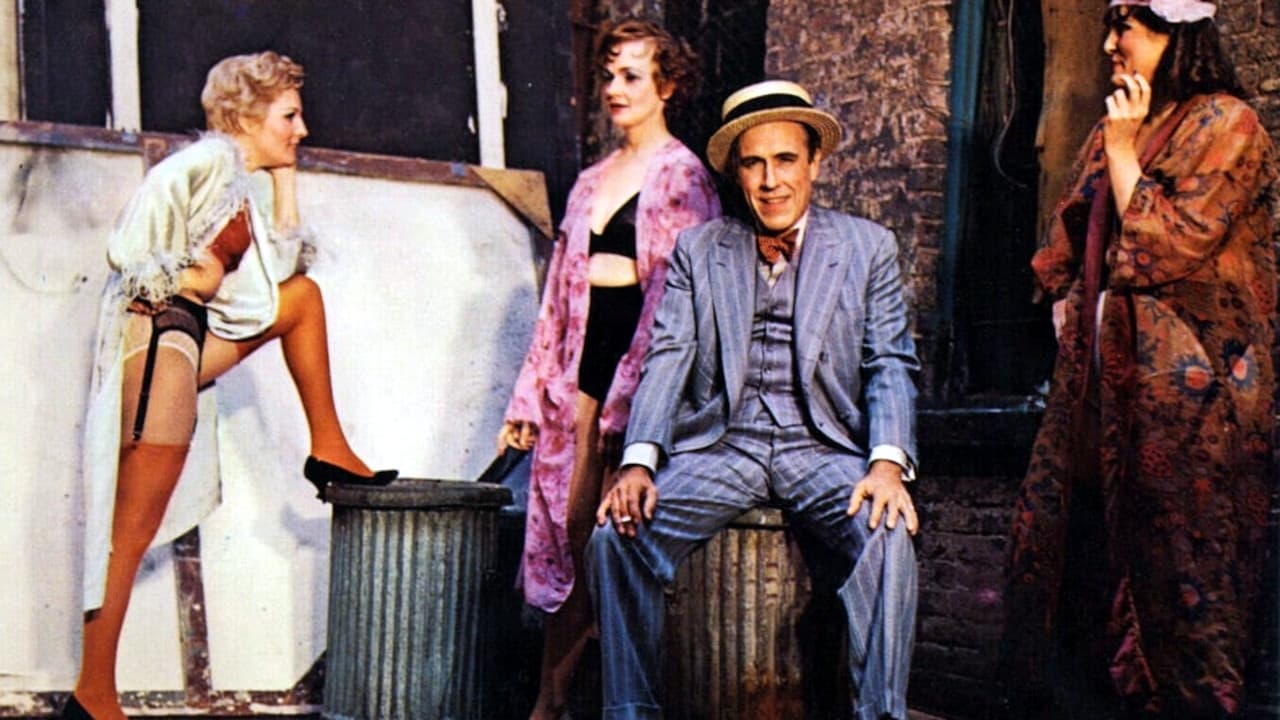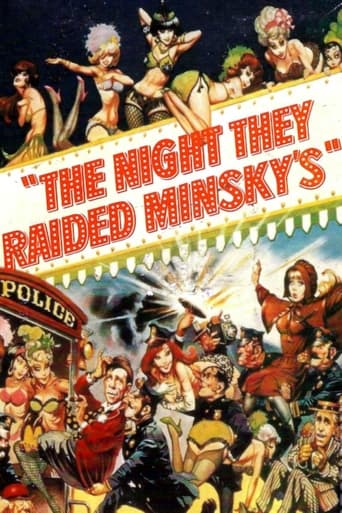

Asinine film where an Amish girl comes to New York to do biblical dancing and winds up at Minsky's Burlesque instead. She is put to the test so that her bible dancing will not lead to a raid; yet, her father shows up and has it out with her causing her to literally bare all.This is a very inane production with a ridiculous plot. Unfortunately, Bert Lahr's part had to be cut as he died suddenly during the production of the film.Jason Robards tries real hard as a king-pin of burlesque, but he is no leading man and his routines are quite stale at best.Britt Ekland is that Amish girl, Elliot Gould runs the club, but is at odds with his orthodox Jewish father, Joseph Wiseman.What's really the point of this total farce?
... View MoreJust a mere coffee break before William Friedkin made an almost consecutive string of such searing naturalistic dramas as The Boys in the Band, The French Connection, The Exorcist and Sorcerer, he showed up with The Night They Raided Minsky's, a low-brow farce which belongs in the pantheon of other throwback vaudevillian screwball romps from the Technicolor 1960s and early '70s, as in Take the Money and Run, the Pink Panther films, What's New Pussycat, It's a Mad Mad Mad Mad World, Bananas and What's Up, Doc? It shares the lagging sense of pace that some of them do---cursing those with one major inferiority to the 1930s and '40s pictures they embrace---as well as the urge to take what could be effective scenes and mash them into clunky montages. It also cannot remotely compare to What's Up, Doc?, the crowning achievement of this trend of the era helmed by Friedkin's New Hollywood rival Peter Bogdanovich. But The Night They Raided Minsky's is not without a secure handling of its risqué content by a director who was hungry for big risks in a period of American cinema where progress was entirely fueled by them.Instrumental in the commercial transformation of Hollywood in only a few short years, Friedkin's films often display a cold cynicism which belies the popular appeal of his future short-lived commercial success. The Night They Raided Minsky's is of a completely different spirit. It is a star-studded ensemble farce, fueled not so much by the breathtaking nature of any scene or story point but by the archetypal bearings of its performers. We have Elliott Gould delightfully playing up his deeply recognized Jewish identity, Denholm Elliott lovingly drawing from his always readily apparent English manners, Jason Robards working his all-American common-man staple. But whether stand-alone scenes work in and of themselves or not, the movie altogether truly appears to grasp this most-American art form.Supposedly, burlesque surged in an era when America was at the onset of the modern moral uprising, when the rural Puritan standards and the makeshift culture of the cities came across one another. Burlesque was basically vaudeville and sex, and in the early days the sex was straightforward, guileless and practically inoffensive. This is the charm of this film, not the pratfalls, the jokes or the farce, even when they work well, which is where Friedkin's stamp really shows itself: Like a Friedkin picture, it is about more than it acts like it is. Friedkin recounts that very period, when there was an exhilaration and flourishing, boisterous burlesque that later vanished. His characters live a talkative, communal life, occupying cafeterias and eating outlandish, hysterically filmed meals. They view burlesque not so much as a profession, more a lifestyle.The plot involves a young Amish girl played by Swedish future Bond doll Britt Ekland, who comes to the big city and is overwhelmed by the flashing marquees. The film opens with Rudy Vallee telling us in a vaudeville style that what we're about to see is based on "really true incidents that actually happened," that "in 1925 there was this real religious girl this real religious girl." Black-and-white images of Model A's on hectic streets, a dancing horse, acrobats, and numerous other impressions whip by, ultimately beholding a lively market street teeming with peddlers and pushcarts that bursts into color. There's a close-up on Ekland riding in bright-eyed on an el train. Her point-of-view peering out at the tenement-lined street erupts from black-and-white to color, as does her making her way down that street. She imbibes the zest and ambiance of a novel world, swarming but exhilarating. Austere gray skies but a vividm multihued event interspersed by more color swings visually signifying her inexperience.Friedkin captures her coming in his naturalistic style of pursuing and exposing action. Her discovery of countless faces, vendors, merchants and ultimately the Minky's Burlesque Theater, is our discovery, too. We become partakers rather than just watchers. And the awareness to minutiae webs with our point-of-view on the marquee dropping to show Bert Lahr chomping a cigar, about to befriend the virginal greenhorn whose perspective we've shared.She longs to dance at Minsky's. She is fought over by two comics (Norman Wisdom and Jason Robards), bird-dogged by her bearded, religious zealot father, and she suddenly, unwittingly and yet glamorously pioneers the striptease. And that moment when she finally invents the strip dance mostly to defy her father and other possessive male figures speaks so many volumes about the futility of utter conservatism and fundamentalism, how the more it pushes and the more it engulfs, the more shocking and extreme each explosion of rebellion and revolution will be, which of course is not to say that the scene itself threatens anything over PG-13 material, but the subtext is there.Friedkin has intentionally employed stereotypes in casting. Ekland is as dovelike and guileless as Joan of Arc and her father is an emigrant from an Early Renaissance allegorical drama. So the story itself takes on some of the reduction and directness of the burlesque skits which freely exposes the action, which tends to compensate for the film's weakness since the editing often becomes a bit too unnecessarily frenzied rather than gazing decisively on the impact of a given image or scene.
... View MoreWilliam Friedkin directed The Night They Raided Minsky's based on the book by Rowland Barber and left immediately afterward. Norman Lear, Sidney Michaels, and Arnold Schulman co-wrote the adaptation, which is evocative of the mid 1920's era. Editor Ralph Rosenblum was left behind to pick up the pieces and shape the material into the form released in December 1968. What's left is a mixture of bawdy humor and a paper thin plot involving backstage doings at a burlesque theater, circa 1925 in New York City. Jason Robards stars as a ne'er-do-well straight man of the theater and teams with Norman Wisdom as a frantic performer, complete with an over-sized suit and make-up. They both try to make time with naive Britt Ekland, a wayward daughter, who arrives in town to escape her overbearing Amish father, Harry Andrews, complete with Amish get up. Robards eventually wins out and has a memorable scene trying to seduce Ekland with a Murphy bed that goes back into the wall and then down again based on the individual accompanied by a knock outside their door. Forrest Tucker plays a gangster rival trying to move in on the theater owned by Joseph Wiseman whose son, Elliott Gould, tries to keep the show running amidst backstage chaos and looming trouble from police led by Denholm Elliott. Rudy Vallee provides the introductory narration, and Bert Lahr has an especially poignant moment at the very end, considering this was his last film. The film moves quite fast and is light-hearted entertainment. The film's highlight comes near the end when Harry Andrews comically tries to bring Ekland, his daughter, back into the fold, unleashing a fire and brimstone speech subsequently undermined by Ekland's defiance and "accidental" exposure on stage. The polarity of the characters mirrors actual burlesque scenarios. Her moment on stage supposedly signaled the dawn of the burlesque era. **1/2 of 4 stars.
... View MoreI will make this prediction NOW....that within 5 years we see THE NIGHT THEY RAIDED MINSKYS turned into a $100 per seat Broadway stage smash.......all the elements are there and like APPLAUSE or THE PRODUCERS one adds reworked or new songs and gives this bawdy burlesque treat a re tread. What this film is about, and the tawdry bump and grind style is a sitter for another go. Have another look at the film.......I'm right about this. Not a big success on first release, it eventually found an audience with THE PARTY, but somehow it is MINSKYS that is actually a better film and a more rewarding film. It was also Bert Lahr's final performance as he died during filming.
... View More